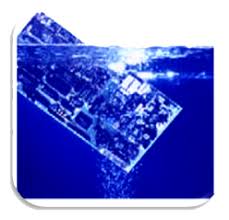Cleaning Methods for Conformal Coating
Posted by Sean Horn
Friday, October 12, 2018 7:30
@ 7:30 AM
Cleaning the substrate is an essential element of preparation for conformal coating. The reasons are easy to understand:
- Severe degradation of the coating’s dielectric strength and insulation resistance can result if the conformal film is applied to contaminated surfaces.
- Adherence may be limited, causing the coating to peel or otherwise disengage from the substrate.
- Rework caused by replacing films detached from unclean surfaces increase labor costs markedly.
While assuring clean substrate surfaces adds to production time and expense, the consequences of applying conformal films to contaminated components is far costlier and more time-consuming. In addition, clients seldom forget incompetent work they pay for, and are likely to take their business elsewhere.
 Major Sources of Contamination
Major Sources of Contamination
There are many sources of contamination, which generally occur before coating is scheduled. Among the most prominent of these are unmonitored manufacturing processes, transport/handling of the devices to-be-coated, and storage, especially for prolonged periods of time. Two broad categories of contaminants exist. It is important to recognize the differences, because each effects the conformal coating process differently.
- Ionic contaminants (ICs) erode into distinct, detached molecules underneath the coating layer. In doing so, they may become conductive, potentially leading to device short-circuit, affecting the entire range of contaminated particles covered by the conformal film. ICs stimulate both corrosion and dendrites, the formation of minute vertical defects in the coating itself. ICs often originate during component manufacture; dissolved salts left from worker perspiration adhering to parts also cause IC.
- While they’re usually effective as dielectrics, non-ionic contaminants (NICs) also lead to collection of debris and other foreign matter beneath the coating. Rather than short-circuiting electronic components, NICs interfere with coating adherence, potentially leaving the substrate exposed to further contamination and dysfunction. Typically, organic materials like grease, oil, or hand lotion cause NICs, but synthetic substances such as rosin or silicone are also NIC originators.
Reliable Testing/Cleaning Methods
Cleaning of electronic devices requiring conformal coating prior to film application is a basic and necessary function of reliable coating procedures. Circuits cleaned prior to conformal coating eliminate the presence of substrate residues, improving ongoing performance. Cleanliness testing is the first step of the process.
In certain cases, a quick-and-dirty test can be implemented by applying water or alcohol to a seen contaminant — water dissolves ICs, but only alcohol will dissolve NICs. Nevertheless, more comprehensive testing is advisably the rule.
ICs are commonly identified using the Resistivity of Solvent Extract (ROSE) method, initiated by measuring the conductivity of a cleaning solution deemed suitable for the project. If conductivity levels are acceptable, washing the substrate with the solution commences. A second test is run following the wash to determine contamination levels. Increase to the solution’s conductivity indicates IC contamination and the need for further cleaning.
Purified water is generally sufficient to clean substrate surfaces of ICs, but care must be taken. Inadequately purified water can deposit further ICs onto the designated surface, compounding the problem. For instance, substances like salt can remain on the substrate after cleansing water has evaporated. Iso-propyl alcohol can also be used to clean ICs.
A residue test equipped with an aluminum-coated glass slide identifies the presence of NICs. The substrate is first rinsed onto aluminum-coated slides with a solution containing acetonitrile. Following solvent evaporation, the substrate is rinsed onto the slide again in a cycle of six repetitions. NICs are detected if residue appears during subsequent inspection. However, the process continues if no residue is detected; the slide is microscopically examined. NICs may appear at this point. If not, a third slide-inspection is implemented, through a precise spectroscopic process using Fourier transform infrared (FTIR) light to reveal any remaining residue. Further cleaning is necessary if NICs are present.
Solvents and surfactants are successfully employed to remove NICs. Typically, a rigorous cleaning is enough to eliminate the problem.
Substrate cleanliness is a major component of the conformal coating process, sufficiently important that the Association Connecting Electronics Industries® (IPC) devised quality standards for conformal coating projects. IPC-HDBK-830 addresses cleanliness issues in section 7.3.3. Substrate cleanliness is essential to conformal coating quality: Clean substrates coat well; those contaminated do not. Devices inadequately clean before application of conformal film suffer severe degradation of insulation resistance and dielectric strength, as well limited coating adhesion. The only way to manage the problem is to inspect and clean the board or other item before applying the coating — once coated, it’s too late.
To learn more about conformal coating and cleaning, download our whitepaper now:
Basics of Conformal Coating Whitepaper
Comments
Homepage 4/17/2020. 10:17:10 AM
... [Trackback] [...] Informations on that Topic: blog.paryleneconformalcoating.com/whats-the-difference-between-potting-and-conformal-coating/ [...]

londondrugscanada.bigcartel.comlondon-drugs 4/17/2020. 10:17:10 AM
cialis uk https://londondrugscanada.bigcartel.com/london-drugs This is nicely expressed. !